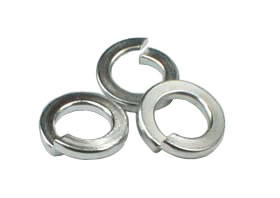
From construction and agriculture automotive and aerospace, washers play an important role in many different industries. They are used in conjunction with a threaded fastener. Placing a threaded fastener through a washer will help to distribute its load across a larger area.
Washers are available in different styles, however. When most people think of washers, they envision the traditional disc-like style. But another common style is lock. Lock washers are used with threaded fasteners just like traditional washers, but they differ in several key ways.
#1) Prevent Loosening
While the primary purpose of traditional fasteners is to distribute the load of a threaded fastener, lock washers are designed to prevent fasteners from loosening. Bolts and other threaded fasteners can come loose. Vibrations, for instance, can cause threaded fasteners to gradually work their way out of the parts with which they are used. Lock washers prevent loosening by providing a resistive force.
#2) Design
Lock washers and traditional washers are designed differently. Nearly all traditional washers consist of a flat, ring-shaped piece of material. As you drive a threaded fastener into a set of parts, the load of the fastener will be distributed across the washer. Lock washers, on the other hand, feature a different design, such as split or tooth. Split washers, as shown above, are raised with a broken segment, while teeth washers have inward- or outward-pointing teeth.
#3) Material
Another difference between lock washers and traditional washers is the material. Because they are used primarily to protect fasteners from loosening, lock washers are made almost exclusively of hard materials, such as hardened steel. Traditional washers, in comparison, are available in both hard and soft materials. For low-stress applications, soft materials may be preferred.
#4) Installation
Lock washers and traditional washers are installed differently. Traditional washers are installed directly below the head of a threaded fastener. They essentially sit between the fastener’s head and the top surface of the part. Lock washers, on the other hand, are installed against a nut. They sit between a nut and the surface of the underlying surface of the part.
#5) Reusability
Traditional washers can typically be reused, whereas many lock washers can not be reused. Lock washers are often single-use because they deform or use friction to prevent fasteners from loosening. As a result, reusing them may result in a loss of performance.
#6) Cost
You may discover that lock washers cost more than traditional washers. This is because they are more complex and often made of heavy-duty materials. Prices can vary depending on many different factors, but many lock washers cost more than traditional washers for this reason.



